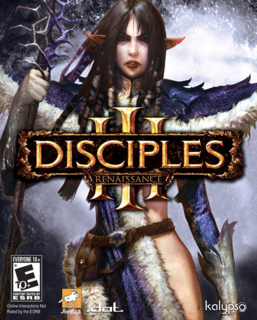Fans of the first two games should find plenty to like--so long as they keep an open mind about what's changed.
The Major Differences:
The most obvious change is that the game is now even more like Heroes of Might and Magic. Whether this is good or bad comes down to the player's preferences, of course, but this reviewer finds the new system to be more enjoyable than Disciples II because it requires some actual involvement in order to win battles. The franchise retains its party-based structure--as opposed to Heroes' army-based structure--which keeps the player invested in his or her troops as opposed to wielding faceless stacks of cannon fodder.
Rod-bearing heroes are gone, replaced by pre-set nodes that can be captured. These nodes are protected by powerful, race-specific spirits once captured, and these spirits automatically upgrade over time. This removes the petty back-and-forth over resource points and replaces them with thought-out, meaningful fights against fairly effective defenses. These points are vital, although the economy is overall streamlined and simplified.
Thieves are now regular heroes, but they still retain some of their unique abilities--simply building a Guild unlocks them--providing more choices for main hero selection. Heroes are overall much more customizable, featuring both Diablo-style stat improvements and a passive upgrade system similar to Final Fantasy XII's License Board. However, this does come at the cost of base individuality; heroes bear no unique starting bonuses to equipment options or ability choices.
Returning Features (and Problems):
The AI is little better than in the original games, so the series continues to be variably difficult; some fights are easy and others are brutal, often with little reason besides enemy party make-up and arbitrary AI targeting decisions. The hex-based maps do, however, contain tiles which provide offensive bonuses and which the AI tends to ignore, giving players a slight edge.
However, players will also find that many units now have new abilities (such as the Titan's deadly earth-magic ability) that make old duds worth reconsidering, both as allies and opponents. This is a welcome addition not only to add value to some little-used veterans, but also to add variety for long-time fans; there are very few new units, and the loss of two races makes this sting a bit more than it would otherwise.
The distinctive art style returns, and is used to great effect. The engine isn't anything to write home about, but the level of detail is far above average, even to the point that items equipped to heroes are visible despite often being too small to be truly noticeable.
Final Judgment:
Disciples III is not revolutionary, yet paradoxically strays far from it's roots. It feels very similar to Disciples II, yet manages to play quite differently in several regards. Ultimately, a player's mileage is likely to depend upon his or her opinion of the previous games. If he or she liked the feel of the world and was hoping for a more involved battle and character development system, then Disciples III may very well be worth a purchase. If the player felt that the simple yet unique mechanics were what set the franchise apart, then he or she may want to steer clear.

